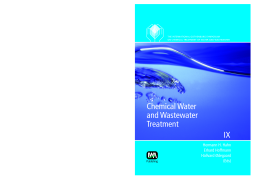
BOOK
Chemical Water and Wastewater Treatment IX
Hermann H. Hahn | Erhard Hoffmann | Hallvard Ødegaard
(2007)
Additional Information
Book Details
Abstract
The question of whether or not we will reach the ambitious goal of the Millennium Declaration still dominates the discussions of water supply and sanitation experts on all levels, governmental, institutional, technological and operational. Our contribution, the Proceedings of the 12th Gothenburg Symposium, the symposium for the sharing of scientific and practical experience in integrated water resources management, is mainly a technological one. This book, as has its predecessors in the series, provides information and technical solutions to accomplish this mammoth task. It is the outcome of collective experience and know-how exchanged between experts in the field of water technology from all over the world, from the Americas, from Central and Southern Africa, from Europe and from different parts of Asia. However, we must realise that very often it is not the technological development that determines progress but rather the legal, financial and organisational framework. And so this book and this symposium differs from its predecessors in that, for the first time, the focus is also on these non-technical aspects that may or may not set the stage for our technological solutions.
The Chemical Water and Wastewater Treatment Series provides authoritative coverage of the key current developments in the chemical treatment of water and wastewater, in theory or practice, and related problems such as sludge production, as well as properties, and the reuse of chemicals and chemically-treated waters and sludges. Chemical Water and Wastewater Treatmentis a valuable resource for managers, scientists, plant operators and others interested in chemical water and wastewater treatment technology.
Table of Contents
| Section Title | Page | Action | Price |
|---|---|---|---|
| Contents | viii | ||
| Regulations, Finance and Political Influence | 1 | ||
| The Principle of Cost-Recovery in Article 9 of the Water Framework Directive – a Price Driver for Water | 3 | ||
| Water Privatization Models: Reasons, Characteristics, Difficulties & Lessons | 11 | ||
| Project Financing as a Model of Private Participation in the Sewerage Sector | 25 | ||
| Chemical Wastewater Treatment | 35 | ||
| The Potential of Chemical and Physical Wastewater Treatment Technologies within the Scope of the EU Water Framework Directive | 37 | ||
| Microscreening in Chemically Enhanced Primary Treatment | 49 | ||
| Optimising Chemical Dosage in Primary Settling Tanks | 59 | ||
| Overcoming Limitations of Biofilm Reactors: Optimising the Solids and Energy Balance | 69 | ||
| Operational Experience in Wastewater Treatment | 81 | ||
| Control of Filamentous Foam Formers by Chemical Addition | 83 | ||
| Phosphorus Removal at the Wastewater Works of St. Petersburg, SUE \"Vodokanal of St. Petersburg | 93 | ||
| Decentralised Treatment of Runoff from Traffic Areas | 103 | ||
| Sludge Treatment and Residuals Recovery | 115 | ||
| Kemicond – Sludge Conditioning by an Acidic Oxidative Treatment – Reaction Mechanisms and Process Optimization | 117 | ||
| New Technologies for the Improvement of Sludge Dewatering | 129 | ||
| Experimental Comparison of Physico-Chemical Treatments for Excess Sludge Reduction in Wastewater Treatment Plants | 141 | ||
| Chemical-Thermal Disintegration of Floating Sludge | 155 | ||
| Coagulants and Flocculants | 169 | ||
| Beyond DLVO: Advancing the Capabilities of Coagulation Process Models | 171 | ||
| Nano-Inorganic Polymer Flocculant: From Theory to Practice | 181 | ||
| Characterization and Coagulation Performance of Liquid Poly-Silicic-Ferric Coagulant (PSF) and Solid PSF | 189 | ||
| Coagulation in Drinking Water Treatment | 205 | ||
| NOM Characteristics and Treatability by Coagulation: Comparison of Norwegian and Australian Waters | 207 | ||
| The Effect of Iron and Aluminium Chemicals in Humic Water Treatment by High-rate Dissolved Air Flotation | 221 | ||
| An Investigation into the Importance of Cell Shape and Algae Derived Organics on the Performance of Coagulation | 231 | ||
| Disinfection | 245 | ||
| Using Engineered Media to Minimize the Chemical Dependency of Filtration | 247 | ||
| A Mechanistic Approach to Predict Disinfection By-Product Precursor Removal during Conventional Coagulation | 257 | ||
| The Use of Hyproform Disinfection System in Wastewater Treatment: Batch and Full Scale Trials | 267 | ||
| Membrane Filtration | 277 | ||
| Impact of Coagulation on the Structure and Hydraulic Properties of Fouling Layers in Submerged Membrane Filtration | 279 | ||
| Ceramic Membranes and Coagulation for TOC Removal from Surface Waters | 289 | ||
| Removal of Selected PhACs and EDS in Surface Water by Membrane Filtration with Biological Filtration Pre-treatment | 297 | ||
| Chemical Treatment for Management of Membrane Concentrate | 307 | ||
| Oxidation in Drinking Water Treatment | 317 | ||
| Impact of UV/H2O2 on Drinking Water Chlor(am)ine Demand and By-products | 319 | ||
| Treatment of NOM-Containing Water by a Photocatalytic-Vacuum UV Reactor | 329 | ||
| Adsorption for Removal of Micro Pollutants | 341 | ||
| Performance Evaluation of Granular Activated Carbon for the Removal of Selected Pharmaceuticals and Endocrine Disrupting Substances from Drinking Water | 343 | ||
| Removal of p-Nitrophenol by Different Types of Ultrafiltration and Powdered Activated Carbon Adsorption | 353 | ||
| Antibiotics Removal Using Oxidation, UV Irradiation and Adsorption | 363 | ||
| Arsenic Removal | 371 | ||
| Purification and Concentration of Phosphorous in Municipal Wastewater by Zirconium Sulfate-Surfactant Micelle Mesostructure | 373 | ||
| Removal of Arsenic by Iron Oxides in Granular Sand Filters in Water Works Treating Groundwater | 381 | ||
| Elimination of Arsenic Substances from Groundwater for Production of Drinkable Water Using Microdrop Reactor System | 389 | ||
| Authors Index | 401 |
